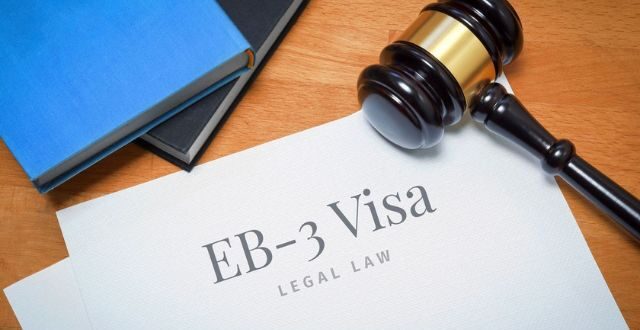The United States of America has long been a land of opportunity, attracting people from all corners of the globe with the promise of a better life and abundant career prospects.
For many, the dream of living and working in the USA is a compelling one, but navigating the complex world of immigration can be daunting. One avenue that offers a path to achieving this dream is the US EB3 visa.
In this comprehensive guide, we will explore the EB-3 visa, its eligibility requirements, application process, and the potential benefits it offers to those seeking to establish themselves in the United States.
Understanding the EB-3 Visa
The EB-3 visa, also known as the employment-based third preference visa, is designed to facilitate the entry of skilled and unskilled workers into the United States. It is part of the larger family of employment-based immigrant visas, each tailored to specific categories of employment-based immigration. The EB-3 visa is particularly appealing to those who have a genuine desire to live and work in the USA permanently.
The Three Categories of the EB-3 Visa
The EB-3 visa is divided into three primary categories, each catering to different skill levels and employment types:
1. EB-3A: Skilled Workers
- This category is intended for individuals with at least two years of job experience or training.
- Eligible positions often require a relevant bachelor’s degree or vocational training.
2. EB-3B: Unskilled Workers (Other Workers)
- This category is for those in occupations that require less than two years of training or experience.
- Job positions in this category might include laborers, housekeepers, or agricultural workers.
3. EB-3C: Special Immigrant Religious Workers
- This category is dedicated to religious workers who are coming to the USA to carry out their religious vocation or occupation.
Eligibility for the EB-3 Visa
Before embarking on the journey to obtain an EB-3 visa, it’s crucial to understand the eligibility criteria for each category.
EB-3A: Skilled Workers
To be eligible for the EB-3A category, individuals must meet the following requirements:
- Possess a relevant bachelor’s degree or equivalent vocational training.
- Have at least two years of work experience in the field.
- Have a full-time job offer from a U.S. employer willing to sponsor their visa.
EB-3B: Unskilled Workers (Other Workers)
Eligibility for the EB-3B category is defined by:
- Less than two years of training or work experience in the desired occupation.
- A full-time job offer from a U.S. employer who is willing to be the sponsor.
EB-3C: Special Immigrant Religious Workers
For the EB-3C category, eligibility is determined by:
- Being a member of a religious denomination that has a non-profit religious organization in the United States.
- Having been a member of the religious denomination for at least two years before applying.
- Receiving a job offer from a U.S. employer in a religious vocation or occupation.
The EB-3 Visa Application Process
Obtaining an EB-3 visa involves a multi-step application process. Here’s an overview of the key steps:
Step 1: Labor Certification
Before filing an immigrant petition, your U.S. employer must obtain a labor certification from the U.S. Department of Labor (DOL). This process involves demonstrating that there are no qualified U.S. workers available to fill the position and that hiring a foreign worker will not adversely affect the wages and working conditions of U.S. workers.
Step 2: Form I-140 Immigrant Petition
Once the labor certification is approved, your U.S. employer can file Form I-140, Immigrant Petition for Alien Worker, on your behalf. This form establishes your eligibility for the EB-3 visa and is submitted to U.S. Citizenship and Immigration Services (USCIS).
Step 3: Visa Bulletin and Priority Date
The availability of EB-3 visas can be subject to annual quotas, so it’s important to monitor the Visa Bulletin published by the U.S. Department of State. Your priority date, which is the date USCIS receives your Form I-140 petition, will determine when you can move on to the next step.
Step 4: Adjustment of Status or Consular Processing
Depending on your circumstances, you will either apply for an adjustment of status if you are already in the United States or go through consular processing at a U.S. embassy or consulate abroad. During this step, you will submit Form I-485 (Adjustment of Status) or attend an immigrant visa interview at the consulate.
Step 5: Visa Issuance
If your visa application is approved, you will receive your EB-3 visa, allowing you to enter the United States and begin your employment with the sponsoring employer.
Benefits of the EB-3 Visa
The EB-3 visa offers several advantages to individuals seeking to live and work in the United States:
1. Permanent Residency
One of the most significant benefits of the EB-3 visa is that it provides a pathway to permanent residency in the USA. Once you obtain the visa, you become a lawful permanent resident (LPR), also known as a green card holder. This status allows you to live and work in the United States indefinitely.
2. Dependents Can Accompany You
EB-3 visa holders can typically bring their spouses and unmarried children under the age of 21 to the United States on derivative visas. This means that your family can join you in your journey to the USA.
3. No Investment Requirement
Unlike some other immigrant visa categories, such as the EB-5 investor visa, the EB-3 visa does not require a substantial financial investment. It is primarily based on your skills and the demand for your occupation in the U.S. job market.
4. Opportunities for Career Growth
The EB-3 visa allows you to pursue a wide range of employment opportunities in the United States. Whether you are a skilled worker or an unskilled laborer, you can find positions that match your qualifications and aspirations.
5. Path to Citizenship
As a permanent resident, you may eventually be eligible to apply for U.S. citizenship, should you wish to do so. This process typically involves meeting certain residency and other requirements, but it’s a potential avenue to becoming a full-fledged American citizen.
Challenges and Considerations
While the EB-3 visa offers numerous benefits, it’s essential to be aware of the challenges and considerations associated with the application process and life in the United States.
Visa Backlogs
The availability of EB-3 visas can be subject to annual quotas and country-specific limitations. As a result, certain nationalities may experience longer waiting periods due to visa backlogs.
Job Stability
EB-3 visa holders are tied to their sponsoring employer during the early stages of the process. Changing employers can be challenging and may require additional steps, such as filing a new labor certification and Form I-140 petition.
Maintaining Permanent Residency
To maintain permanent residency, you must reside continuously in the United States. Extended periods of absence or failure to meet other residency requirements may lead to the loss of your green card.
Legal and Financial Considerations
Navigating the U.S. immigration system can be complex. It’s advisable to seek legal counsel to ensure that you meet all requirements and adhere to immigration laws. Additionally, consider the financial implications of relocating to a new country.
Conclusion
The EB-3 visa offers a promising path to achieving your dream of living and working in the United States. While the application process may be lengthy and challenging, the potential benefits, including permanent residency and opportunities for personal and career growth, make it a viable option for many individuals.
If you are considering the EB-3 visa as your stepping stone to the USA, be sure to thoroughly research and understand the eligibility criteria, application process, and associated challenges. With the right guidance and determination, you can turn your American dream into a reality.
 khamush.com Lifestyle | Motivation | Poems
khamush.com Lifestyle | Motivation | Poems



